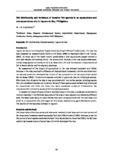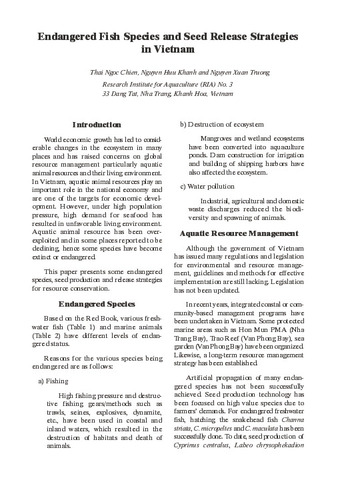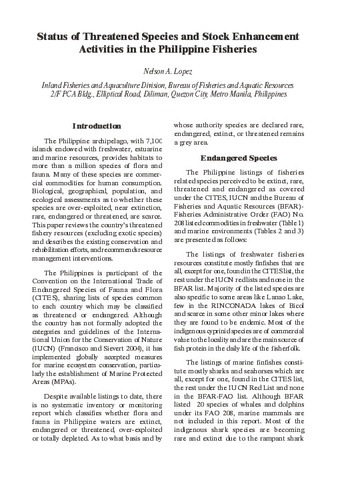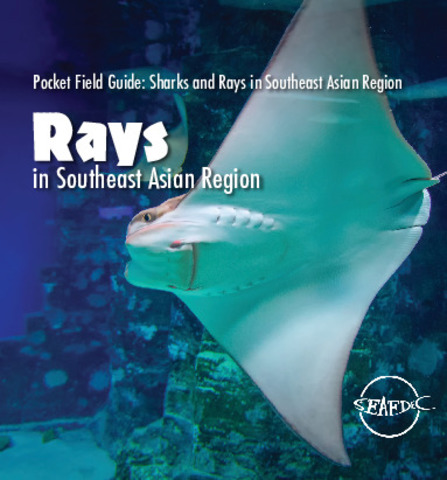Fish biodiversity and incidence of invasive fish species in an aquaculture and non-aquaculture site in Laguna de Bay, Philippines
Share
Abstract
Laguna de Bay is the Philippines' largest inland water with 900 km2 surface area. The lake has been assessed as hypereutrophic (Rohani and Roblo, 1984) to dystrophic (Barril and Tumlos, 2002). To make use of the lake's natural productivity a pilot aquaculture project started in 1971 (del Mendo and Gedney, 1979). The aquaculture industry in the lake rapidly developed, mainly using species not native to the lake. Since then, the lake has become a major source of fish in Metro Manila and the adjacent provinces.
An assessment of the impact of aquaculture in the lake showed increased total finfish biomass in the lake; ecotrophic efficiency of phytoplankton increased; and the calculated total net primary production decreased by a factor of two compared to the pre-aquaculture period (de los Reyes, 1993). The dominant species cultured in Laguna de Bay are introduced species. After more than 40 years the lake is now populated with non-native species including species that are considered invasive and nuisance. Many of these species were deliberately introduced for aquaculture and there are those that were considered accidental introductions like ornamental fish cultured in ponds within the lake's watershed.
To assess the impact of aquaculture in localized areas in the lake, a study was conducted to monitor diversity in the fisheries resources of the lake at two adjacent, but distinctly different sites: the West Cove (WC), an open fishery area, with no aquaculture and the East Cove (EC) which is an aquaculture site with cages for Nile tilapia, bighead carp, giant freshwater prawn.
Suggested Citation
Cuvin-Aralar, M. L. A. (2014). Fish biodiversity and incidence of invasive fish species in an aquaculture and non-aquaculture site in Laguna de Bay, Philippines. In C. Biscarini, A. Pierleoni, & L. Naselli-Flores (Eds.), Lakes: The Mirrors of the Earth. Balancing Ecosystem and Human Wellbeing. Proceedings of the 15th World Lake Conference (Vol. 2, pp. 53-57). Italy: Science4Press.
Subject
Collections
Related items
Showing items related by title, author, creator and subject.
-
Endangered fish species and seed release strategies in Vietnam
Chien, Thai Ngoc; Khanh, Nguyen Huu; Truong, Nguyen Xuan (Aquaculture Department, Southeast Asian Fisheries Development Center, 2006)World economic growth has led to considerable changes in the ecosystem in many places and has raised concerns on global resource management particularly aquatic animal resources and their living environment. In Vietnam, ... -
Status of threatened species and stock enhancement activities in the Philippine fisheries
Lopez, Nelson A. (Aquaculture Department, Southeast Asian Fisheries Development Center, 2006)The paper provides the lists of fisheries related species perceived to be extinct, rare, threatened and endangered as covered under the CITES, IUCN and the Bureau of Fisheries and Aquatic Resources (BFAR)-Fisheries ... -
Pocket Field Guide: Rays in Southeast Asian Region
Southeast Asian Fisheries Development Center (Secretariat, Southeast Asian Fisheries Development Center, 2021-01-26)This Pocket Field Guide: Sharks and Rays in Southeast Asian Region was prepared through a series of activities at national/ regional levels aimed at supporting SEAFDEC Member Countries in the implementation of CITES ...






